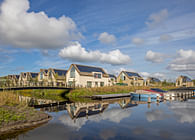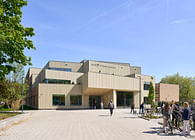
The Hague, NL
The British School of Amsterdam founded in 1978, offers a British international education to 900 children aged from three to 18. Located in Amsterdam Oud-Zuid, the school is made up of three sections: Early Years, Junior School and Senior School. The school follows the National Curriculum for England and the pupils take SATs in Key Stage 1 and 2. In the Senior School, pupils sit GCSEs and A-Levels. The school is accredited by the UK Government as a British School Overseas and is a member of the Council of British International Schools (COBIS).
Atelier PRO, in collaboration with Van Hoogevest Architects, transformed a former prison into a primary and secondary school for The British School of Amsterdam.
Until 2021, The British School of Amsterdam (BSA) was housed at three different locations in the city. For the future, the BSA wanted to have one building in which the three different schools (Early Years, Junior and Senior) could be housed in a single location, preferably in a building with character and history. This was achieved with the purchase of the former penitentiary at Havenstraat 6 in Amsterdam. This building, set up as a panopticon, was designed and built between 1888 and 1891 to a design by W.C. Metzelaar, state engineer-architect for prison buildings. The BSA formulated the task for us architects as follows: "To turn around the function of the building where everyone wants to get out to a school where everyone wants to stay."
Vision
In our vision, we wanted the building to rise as an urban block. Where the old prison wall once stood, a tree-lined schoolyard has now been created, a space full of character for leisurely recreation, sport and play. In the process, the building was cleared of later additions and restored as a monolith. We have transformed the closed prison building into an expressive children's world, in which all three schools have a recognisable place. The DNA of the BSA as a whole remains clearly legible, while each individual school also has its own character.
Three schools, four wings
The programme did not fully fit into the existing building, so new construction had to be added. The former prison was designed as a panopticon, with four wings around a central space. Three wings consisted of cell blocks, the fourth shorter wing, housed the chapel, among other things. This made it obvious to give each school one wing, consisting of a part of the old building supplemented by new construction. The shorter wing serves as the entrance for all pupils; it leads to the central area, which is opened up to the four wings with two-storey windows and acts as a crossroads in the school.
A stimulating interaction
In order to make the existing building suitable for education, the cells have been provided with extra windows and interconnected to form larger spaces; extra floors and stairs have been added in the voids of the cell wings. By removing the 20th-century annexes, the monument is visible again; historical details have been restored as much as possible to their former glory. The new building is executed in bricks that match the existing architecture. This creates a stimulating interaction between old and new, whereby the intrinsic qualities of the historic prison building are utilised - but with a new atmosphere.
A school in old prison
Within the size and structure of the monument, the teaching spaces reach their full potential and enhance the possibilities of the new building. They are new spaces for the educational landscape, with a smart structure to make them as sustainable and future-oriented as possible. They are zoned to create a natural transition between social and dynamic spaces and quiet educational spaces, full of concentration and depth.
Unity and diversity
The identity of the building arises both from the school character as a whole and from the individuality of the various schools - with their different groups of pupils and age categories. Each age group has its own place, which supports the social structures in terms of size and atmosphere, and which does full justice to the homely and secure atmosphere of the British School. A single British School was developed; at the same time, each school was given its own appearance within the whole.
What was once a closed and introverted prison building is now a lively, safe and unified school.
Status: Built
Location: Amsterdam, NL
Firm Role: Project architect
Additional Credits:
Client: The British School of Amsterdam
Project architect: atelier PRO with Van Hoogevest architecten
General contractor: Heddes Bouw & Ontwikkeling
Acoustics & physics consultant: Deerns
Structural engineer: IMd Raadgevende Ingenieurs
Restauration architect: Van Hoogevest Architecten
Photography: Eva Bloem

